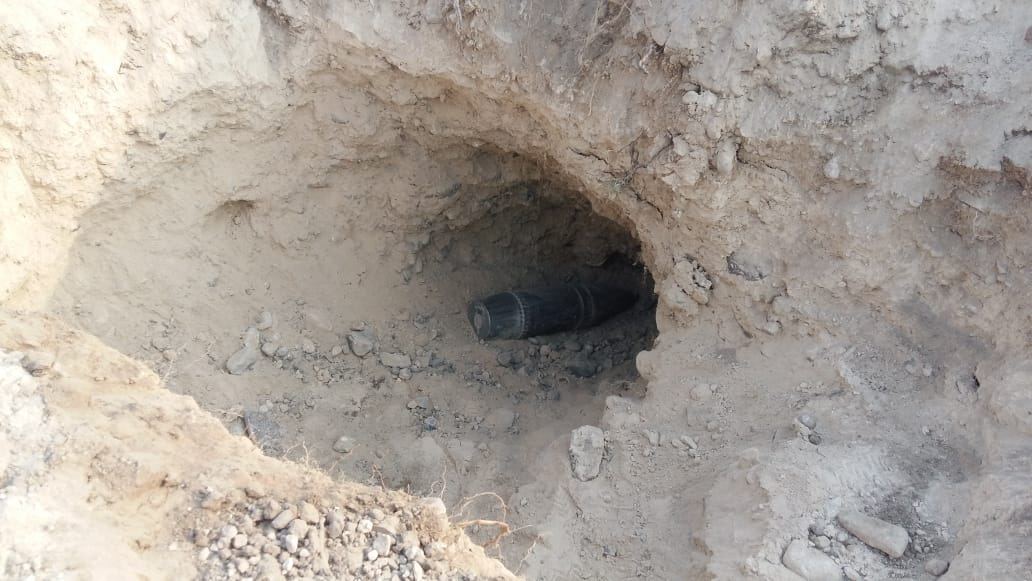Armenia's forces used prohibited white phosphorus bombs in recent attacks on the Tartar city of Azerbaijan located near the Nagorno-Karabakh region, which is the internationally recognized territory of Azerbaijan but occupied by Armenia.
According to local media reports, two white phosphorus bombs were dropped by Armenia's troops on Tartar on Tuesday. The munitions hit an empty area in the Sahlabad village without exploding. The Azerbaijan National Agency for Mine Action (ANAMA) have located and neutralized the explosive devices on the ground.
"Excavations on the site revealed that the bombs are two artillery-delivered 120-millimeter white phosphorus munitions of P-4 type. The projectiles contain approximately 3.8 kilograms of white phosphorus," said Madat Mammadov, operations manager at ANAMA.
Before the Tartar district, Armenia's army launched white phosphorus projectiles on the Fuzuli district on October 8.
White phosphorus is a highly flammable incendiary material, which ignites when exposed to oxygen. The chemical substance flares in spectacular bursts with a yellow flame when fired from artillery shells and produces dense white smoke. It serves as a smokescreen for troop movements and to illuminate a battlefield.
White phosphorus has a significant, incidental, incendiary effect that can cause severe damages to humans and civilian objects in the vicinity. Human Rights Watch say the infection from white phosphorus is common and the body’s absorption of the chemical can cause serious damage to internal organs, as well as death. It could lead to destructive effects on the environment and may remain within the deep soil for several years without any changes.
The international law outlines white phosphorus as an incendiary weapon, defined by Protocol III of the Convention on the Prohibition of Use of Certain Conventional Weapons as “any weapon or munition which is primarily designed to set fire to objects or to cause burn injury to persons through the action of flame, heat or combination thereof, produced by a chemical reaction of a substance delivered on the target.” The protocol prohibits using air-delivered incendiary weapons against military targets located among civilians, and limits the use of incendiary weapons delivered by other means.
Hikmat Hajiyev, senior aide to the president of Azerbaijan, said Armenia's use of white phosphorus munitions contradicts the international conventions to which it is a party. Armenia has an obligation not to use such weapons. Hajiyev added that main purpose of Armenia's use of such weapons is to inflict damages on the Azerbaijani Armed Forces and civilians. He went on to call on the international community to take the issue into a serious consideration.
The fighting between Armenia and Azerbaijan began on September 27 after Armenian troops deployed in the occupied Azerbaijani lands shelled military positions and civilian settlements of Azerbaijan. The uninterrupted bombardment triggered counter-attack measures by the Azerbaijani army to push back Armenia's offensive. Intensive deployment of military materiel and personnel to the frontline by both sides transitioned the fighting into the largest-scale clashes between the sides since a ceasefire reached in 1994. Since the start of hostilities to date, the Azerbaijani army has liberated the occupied cities of Jabrayil, Fuzuli, Zangilan and Gubadli, as well as dozens of villages, settlements and strategic heights in the districts of Tartar, Fuzuli, Jabrayil, Khojavend, Zangilan, Gubadli and Kalbajar.
According to data compiled by the Prosecutor General's Office of Azerbaijan, missile fires launched by Armenia's forces killed 92 civilians and wounded 404 others in multiple cities of Azerbaijan, including Tartar as of November 6. Tartar is the most bombed European city post World War II, according to data compiled by the government of Azerbaijan.
Armenia and Azerbaijan have been locked in a decades-old conflict over the Nagorno-Karabakh region, which is the internationally recognized territory of Azerbaijan but occupied by Armenia. Following the Soviet Union’s dissolution in 1991, Armenia launched a military campaign against Azerbaijan that lasted until a ceasefire deal was reached in 1994. Armenia occupied 20 percent of Azerbaijan’s internationally recognized territories including the Nagorno-Karabakh region and seven surrounding districts. Over 30,000 ethnic Azerbaijanis were killed and one million were expelled from those lands in a brutal ethnic cleansing policy conducted by Armenia.
Although the United Nations Security Council adopted four resolutions demanding the immediate withdrawal of the occupying forces from the Azerbaijani lands and the return of internally displaced Azerbaijanis to their ancestral lands, Armenia has failed to comply with all four legally binding documents.







 Armenian sappers commenced on Monday mine-clearance operations in the territories adjacent to the Saint Mary Church in village of Voskepar (Armenia...
Armenian sappers commenced on Monday mine-clearance operations in the territories adjacent to the Saint Mary Church in village of Voskepar (Armenia...
 Russian Foreign Minister Sergei Lavrov has reasserted that Moscow has no intentions to stop the fighting in Ukraine, even if peace talks commence.
Russian Foreign Minister Sergei Lavrov has reasserted that Moscow has no intentions to stop the fighting in Ukraine, even if peace talks commence.
 Iran has refuted reports of alleged damage to Shimon Peres Negev Nuclear Research Centre located southeast of Dimona, Israel, during the recent air...
Iran has refuted reports of alleged damage to Shimon Peres Negev Nuclear Research Centre located southeast of Dimona, Israel, during the recent air...
 Iran’s Foreign Minister, Hossein Amir-Abdollahian, has labeled a foiled Israeli drone attack in certain parts of the country as a "failure" for Isr...
Iran’s Foreign Minister, Hossein Amir-Abdollahian, has labeled a foiled Israeli drone attack in certain parts of the country as a "failure" for Isr...



